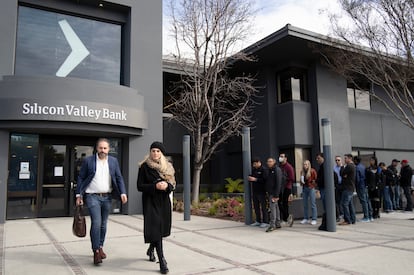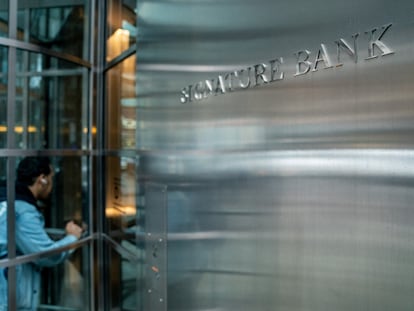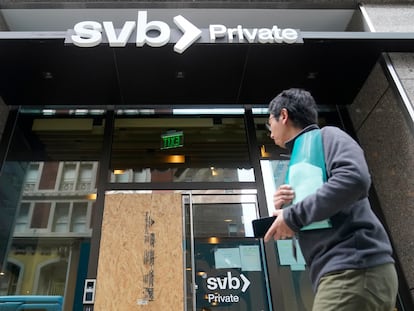Financial panic upends central banks’ battle against inflation
The collapse of Silicon Valley Bank has prompted more calls for slower interest rate hikes, but it is not clear whether authorities should heed them

Globalization produces infinite versions of the famous fluttering of the butterfly capable of causing a tornado on the other side of the world. The impact on the stability of the financial system caused by the collapse of Silicon Valley Bank (SVB) has given new arguments to supporters of slower interest rate hikes by central banks.
Acting as if nothing had happened, they believe, could lead to new financial corpses: small or midsized entities with poor risk control or high exposure to heavily depreciated government bonds. The market’s growing expectation of slower rate hikes has already generated, all by itself, a significant drop in the Euribor, a benchmark used to calculate mortgage interest rates in Europe: on Tuesday it dropped from nearly 4% to just over 3.5%. This index is closely monitored by households with variable-rate mortgages who have been grappling with growing monthly payments in recent times.
US investment bank Goldman Sachs was one of the first to warn about the impact of the financial meltdown on monetary policy. It caused surprised by noting that it was not expecting any action by the Federal Reserve at its meeting next week. Before the run on Silicon Valley Bank, most experts had been talking about a rise of 50 basis points or 25 at the very least. It is not clear whether Goldman Sachs’ prediction will come true, but its mere enunciation has reignited the debate between the two conflicting sensibilities: hawks – defenders of continuing with tighter monetary policy – and doves – who are inclined to slow down to avoid hurting growth. The release of US inflation data this Tuesday did not dispel doubts: prices rose by 6%, four tenths of a point less than in January and the eighth consecutive month of moderation, but still too high to do nothing about it, at least not in a normal scenario.
The current scenario, however, seems anything but normal. There are ominous echoes of past financial crises and mistimed rate hikes, like Jean-Claude Trichet’s notorious July 2008 blunder when he was at the helm of the European Central Bank. There are also comparisons (though probably exaggerated) with the meltdown unleashed by the collapse of Lehman Brothers. Against this backdrop, there is renewed expectation around the role of central banks. Gilles Moëc, chief economist at the global investment management firm AXA IM, expects some kind of gesture from them: “It is likely to trigger more prudence from the Fed in the area of monetary policy. In the very short term, it will be difficult for the Federal Reserve to ignore the SVB episode, although in theory financial stability concerns should not affect monetary policy decisions.”
Antonio Carrascosa, a financial expert from Spain who once headed the FROB, a government agency created in 2009 to manage the restructuring of Spain’s then-struggling banking sector, thinks it more likely that the interest rate rises will begin to slow down in the US. “Financial stability is crucial. A financial crisis is crushing. Look what happened in 2008: financing dries up, unemployment rises, growth falls...,” he said in a telephone interview. Experts at BBVA Research, on the other hand, said they are not expecting any deviation from the path of rate hikes by central banks, which appear obsessed with the fight against runaway inflation.
Some answers may be afforded by the meeting of the European Central Bank scheduled for this coming Thursday. The forecasts say there will be a rise in interest rates of 50 basis points, to reach 3%. Anything else would come as a surprise, and surprises don’t always go down well, as they imply a tacit admission of concern about aftershocks. Analysts and investors will be very attentive to possible clues in the speech of ECB President Christine Lagarde.
The EU finance ministers keep insisting that European financial institutions have no direct exposure to SVB, and underscore that their business model is very different from that of the US firm, which was based on serving thousands of technology companies. Nor do European banks hold such a high proportion of public debt. “The weight of sovereign bonds on equity is infinitely lower,” says Leopoldo Torralba, an economist at the asset management and investment firm Arcano.
Even so, European banks have not been spared significant falls on the stock market. This is partly because if central banks lift the foot of the rate accelerator, they may stop earning as much from their variable-rate loans, and partly because of the wave of mistrust that is sweeping the sector, causing investors to flee without discriminating between healthy and vulnerable entities. For Carrascosa, these are irrational market movements. “If SVB had issued bonds and the Spanish banks had bought them, as happened with the subprime mortgages, it could be understandable,” he explains.
It is not the case. And all indicators point to disastrous management as the first cause of SVB’s collapse. There are no subprime mortgages and no mountains of bad loans involved. Just a few US Treasury bonds – one of the safest assets in the world – bought at the wrong time and for the wrong maturity date by bank executives who then rushed to sell them at huge losses, launched a desperate bid to raise capital and did a poor job of communicating each of these steps. But the largest bank failure in the US since Washington Mutual in 2008 is no small event. Underestimating the potential of crises to reproduce or mutate, or the power of mistrust as an engine of destruction, has already left us with bad experiences in the past. For this reason, the situation seems like a Catch-22 for central banks: if they slow down their interest rate hikes and inflation picks up, they will be blamed for it. And if the rate hikes continue and the banking crisis deepens, they will also be blamed for it. It’s a case of damned if you do and damned if you don’t.
Sign up for our weekly newsletter to get more English-language news coverage from EL PAÍS USA Edition
Tu suscripción se está usando en otro dispositivo
¿Quieres añadir otro usuario a tu suscripción?
Si continúas leyendo en este dispositivo, no se podrá leer en el otro.
FlechaTu suscripción se está usando en otro dispositivo y solo puedes acceder a EL PAÍS desde un dispositivo a la vez.
Si quieres compartir tu cuenta, cambia tu suscripción a la modalidad Premium, así podrás añadir otro usuario. Cada uno accederá con su propia cuenta de email, lo que os permitirá personalizar vuestra experiencia en EL PAÍS.
¿Tienes una suscripción de empresa? Accede aquí para contratar más cuentas.
En el caso de no saber quién está usando tu cuenta, te recomendamos cambiar tu contraseña aquí.
Si decides continuar compartiendo tu cuenta, este mensaje se mostrará en tu dispositivo y en el de la otra persona que está usando tu cuenta de forma indefinida, afectando a tu experiencia de lectura. Puedes consultar aquí los términos y condiciones de la suscripción digital.











































